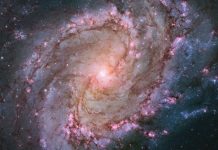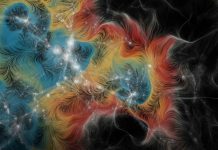
Imagine you’re an alien astronomer, millions of light years away, looking at our Milky Way galaxy through your super-powered space telescope.
What would you see? Would our galaxy seem special or pretty common compared to others?
A team of scientists from the Max Planck Institute for Astronomy asked these questions, and their results might surprise you.
The researchers were interested in our galaxy’s chemical make-up. Just like each of us is unique because of our DNA, each galaxy is unique because of its chemical composition.
Stars, including our own Sun, are made mostly of hydrogen and helium.
But there’s also a sprinkle of heavier elements, like carbon, oxygen, and iron—what astronomers call “metals”. As galaxies age, stars make more and more of these metals and throw them out into space when they die.
This means younger stars usually have more metals than older ones.
Over the last decade, we’ve made big strides in studying our galaxy. Surveys, like APOGEE, and spacecraft, like Gaia, have given us a lot of information about the stars in our galaxy.
We also have a lot more data about other galaxies, thanks to surveys like MaNGA. Plus, we have powerful computer simulations that let us model how galaxies evolve over billions of years.
The scientists started by using the APOGEE data to look at the distribution of metals in stars throughout the Milky Way.
They found that the concentration of metals in stars is highest at about 23,000 light-years from the center, drops again further out, and then falls to about a third of the solar value around 50,000 light-years from the center.
So, how does the Milky Way stack up against other galaxies? The researchers found that only about 11% of the simulated galaxies and about 1% of the real galaxies surveyed by MaNGA have a similar pattern of metal content. This means our Milky Way is a bit of an oddball, but not completely unique.
So why does our Milky Way have this oddball pattern? The researchers have a few ideas. It could be due to the formation of the “bulge” of older stars around our galactic center, or maybe our galaxy’s central supermassive black hole inhibited star formation in the past.
Or, our galaxy might have once swallowed a smaller, metal-poor galaxy, or our estimates for the size of the Milky Way might be off.
This research opens up many new questions about our galaxy’s past, but it also shows us a new way to compare our home galaxy to others.
And who knows, maybe one day we’ll find out if those hypothetical alien astronomers find our galaxy as fascinating as we do!
The study was published in Nature Astronomy.



